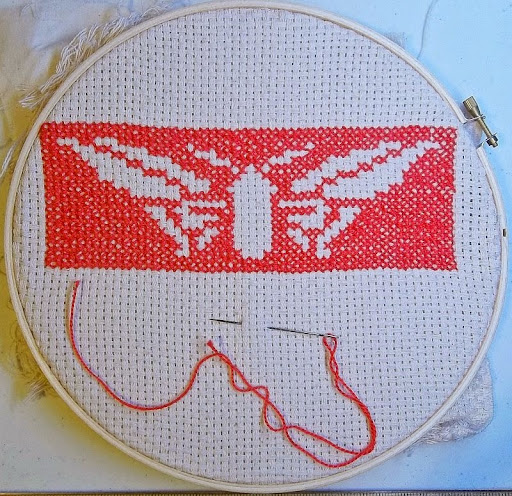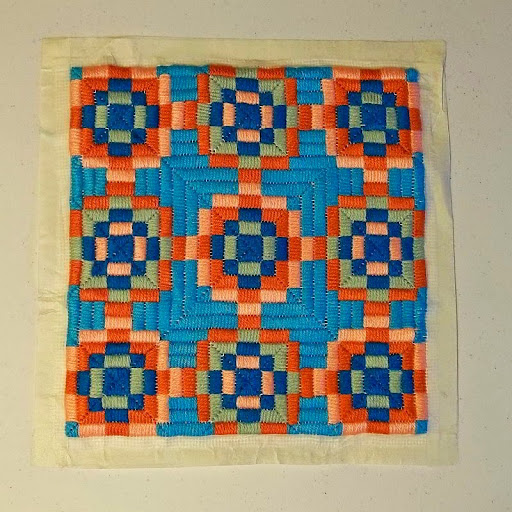 Assisi work is a very old form of counted-thread embroidery. Its first known use was in the late 13th or early 14th Century. The name comes from Assisi, Italy, the little town in Umbria made famous by its association with Saint Francis of Assisi. Many of the best examples, made by nuns in convents for use as altar cloths in cathedrals, have managed to survive. They were worked on white linen with single colors of silk thread. The colors used were red, blue, yellow, green and brown. Only the silhouettes of the subjects were outlined; the backgrounds were worked solidly. The subjects were primarily Biblical scenes, with some mythological subjects and stylized animals and plants. The technique remained popular in church circles throughout the 17th Century.
Assisi work is a very old form of counted-thread embroidery. Its first known use was in the late 13th or early 14th Century. The name comes from Assisi, Italy, the little town in Umbria made famous by its association with Saint Francis of Assisi. Many of the best examples, made by nuns in convents for use as altar cloths in cathedrals, have managed to survive. They were worked on white linen with single colors of silk thread. The colors used were red, blue, yellow, green and brown. Only the silhouettes of the subjects were outlined; the backgrounds were worked solidly. The subjects were primarily Biblical scenes, with some mythological subjects and stylized animals and plants. The technique remained popular in church circles throughout the 17th Century.
By the 18th century, however, the embroidery work had passed from the nuns to the women of the town of Assisi, where it became a cottage industry for them. The subjects became more secular and they were then used on household linens. The motifs were outlined in one color (usually black), while the backgrounds were worked in a second color (often red or green). Some women began experimenting with less traditional color combinations, such as rose and blue or blue-gray and gold. Elements of the technique became incorporated with more widespread folk embroidery. If you look carefully at the enlargement of this counted-stitch embroidery on evenweave linen, you will see tiny flowers that are not embroidered, but simply suggested by the stitches around them.
 |
| Assisi butterfly in red on white monk's cloth |
Today you need not be limited by any of the traditional restrictions. Indeed, the simplest subjects need not be outlined at all; Their inner structure is shown by extending the background stitches inside their silhouettes. An example is this piece, first shown on the post for April 30, 2014. The colors used here are the traditional red-on-white, but it is perfectly possible to use any color (or colors) of thread on any other color of background –- even black. There are many ways in which you can use this simple and versatile style of embroidery to express your indiviual taste and personality.
 |
| Sampler for some Assisi background stitches |
The most common background stitches are conventional (left-over-right, stitched in two different passes) cross-stitches, but other alternatives include two-sided cross-stitch (right-over-left, each stitch completed before the next is begun), zigzag stitch (cross-stitches with upright stitches between them), long-armed cross-stitch, four-sided stitch, and detached filling stitches like wheatear and French knot. Three of these stitches are shown on this sample, first in a single color and then with two colors used to make the stitch pattern clearer. (Top to bottom, long-armed cross-stitch, zigzag stitch, four-sided stitch.) There are several versions of long-armed cross-stitch; I've chosen a simple one. The four-sided stitch can be used as a detached filling stitch. Outlining is usually done in back-stitch or double-running stitch (sometimes called Holbein stitch). That doesn't mean you can't use outline stitch, stem stitch, chain stitch or even couching.
Nor do you need to use a linen background and silk thread. Cotton fabrics and cotton or rayon floss, craft threads, and crochet cotton are inexpensive, readily available, easy to use and come in a multitude of colors. Hardanger cloth and Aida are strong contenders for this type of work. I have a special fondness for linen thread and tapestry wool on coarser fabrics like hopsacking, wool, wool blends and decorator burlap. (Whatever you use, use something that will not cause discomfort to your eyes or hands.) The project shown here is a multiflora rose outlined in a single strand of J&P Coats™ craft thread. The background is worked in six-strand DMC™ floss on monks' cloth. Several closely-related shades of red were used.
 |
| Outline of "JOY" embroidery, ready for Assisi background |
The yellow and green center stripes were measured so that each would fill exactly half of the space allotted for the letter “O”. The other stripes are slightly wider. I wanted the blue and orange stripes to encompass the majority of their letter spaces and the red and purple ones to cover the small parts left over. I decided to leave a margin of the unstitched background fabric at either end of the embroidery to set it off. This picture shows the project completed, hemmed, and ready to frame.
 |
| Assisi embroidery of iris on needlepoint canvas |
I had never seen Assisi work done on needlepoint canvas, but I could see no reason not to try it. I drew a simple outline of an iris bloom and a bit of stem and traced it with pencil onto #10 mono canvas. I worked the outlines of the design in continental stitch and the background in basketweave stitch. I decided it needed a bit of a second color, so I did the “stamens” in doubled six-strand floss. I like the result and am now planning a long horizontal panel with several flowers, done so the white canvas becomes the flower, each with a different color background. There may be a place for that little butterfly somewhere in the panel, too.
I believe my interest in Assisi work stems from my fascination with positive and negative shapes in design. If you want to see the work of a master of positive/negative design (and one of my two favorite artists of all time), look for pictures by Dutch artist M. C. Escher (Maurits Cornelis Escher, 1898–1972). They will exercise your mind and your imagination.
As for Assisi work --- try it. You'll like it!













